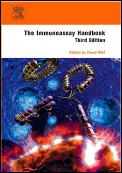Description
Immunoassays are biochemical tests that rely on antibodies (a special
type of protein) to bind to specific molecular structures (antigens).
They have become the most commercially successful technology in
diagnostics, from home pregnancy testing kits to AIDS testing. Highly
illustrated and clearly written, The Immunoassay Handbook provides an
excellent guide to this fast-growing industry. Revised and updated,
this third edition offers a balanced review of practical information
and clinical applications in the field of immunoassay technology.
Comprehensive and expertly written, The Immunoassay Handbook will be
invaluable for a wide range of users from researchers developing
immunoassay systems to developmental and marketing staff who need an
excellent overview of how immunoassay principles, systems and
applications work. With 68 chapters covering a wide range of topics,
and new chapters looking at: surface plasmon resonance in kinetic,
concentration and binding site analyses, and the foundations of
immunochemistry, this handbook is a must read for all laboratory
researchers and academics who use immunoassay as a tool including:
pathologists, clinical and veterinary chemists, biochemists, students
and researchers in immunology, biochemistry and medicine.
-Contents -
Part 1 Principles
Chapter Headings.
Introduction to immunoassay principles (C. Davies).
Non-competitive immunoassays for small molecules - the anti-complex,
selective antibody and apposition systems (C.H. Self et al.).
Ambient analyte assay (R. Ekins).
Free analyte immunoassay (N.D. Christofides).
The foundations of immunochemistry NEW (R.F. Ritchie).
Concepts (C. Davies).
Immunoassay development in the in vitro diagnostic industry (D.
Brandt, S. Figard).
Antibodies (E. Liddell).
Standardization and calibration (D. Wild).
Separation Systems (D. Wild, W. Kusnezow).
Signal Generation and Detection Systems (Excluding Homogeneous Assays)
(L.J. Kricka, D. Wild).
Homogeneous immunoassays (E.F. Ullman).
Calibration curve-fitting (B. Nix, D. Wild).
Conjugation methods (A.H. Dent).
Immunological biosensors (J.K. Gimzewskiet al.).
Surface plasmon resonance in kinetic, concentration and binding site
analyses (R. Karlsson et al.).
Lab-on-a-chip, micro-and nanoscale immunoassay systems (L.J. Kricka,
D. Wild).
Part 2 Product Technology
Introduction to product technology in clinical diagnostic testing (D.
Wild).
Market trends (D. Huckle, D. Wild).
Choosing an automated immunoassay system (L.J. Sokoll, D.W. Chan).
Automated system features (A. Truchaud et al.).
Over-the-counter pregnancy test kits (M.J. Wheeler).
Fluorescence microscopy: Microtrak (T. Houts).
Automated batch analyzers: IMx (K. Ford).
Automated bulk reagent random-access analyzers: UniCAP 100 (G. Evans,
M. Rilven).
Automated panel analyzers: PRISM (D. Shah, J. Stewart).
Unitized reagent random-access analyzers: IMMULITE? and IMMULITE 1000
(A.L. Babson).
Bulk reagent random-access analyzers: ACS:180? SE (E. Gramignano).
Bulk reagent random-access analyzers: AxSYM? (T. Donahoe).
Bulk reagent random access analyzers: Elecsys? Immunoassay Systems
(T. Atkinson).
Bulk reagent random-access analyzers: Vitros? ECi (D. Wild).
Bulk reagent random-access analyzers: IMMULITE?2000 and IMMULITE 2500
(A.L. Babson).
Bulk reagent random-access analyzers: ADVIA Centaur? (L. Taylor, E.
Gramignano).
Bulk reagent random-access analyzers: ARCHITECT? i2000? andi2000SR?
analyzers (F.A. Quinn).
CEDIATM, a homogeneous enzyme immunoassay system (W.A. Coty, R. Loor).
Clinical Chemistry Analyzers: VITROSTMTM Immuno-Rate and MicroTipTM
Assays (S.J. Danielson, D.A. Hilborn).
Near-patient tests: the Triage? system (K.F. Buechler).
Near-patient tests: Stratusa CS acute careTM diagnostic system (W.N.
McLellan).
Over-the-counter tests: Clearblue pregnancy testa, Clearblue
ovulation testa and Cle


